Christine Heinrichs, veteran chicken writer, walks you through how to successfully show your poultry to judges at shows and fairs.
The idea of keeping chickens may have occurred to you while you were walking the aisles at a local poultry show. “All these beautiful birds! I could do this.”

Chickens on display for judging.
People like to participate in shows for all sorts of reasons. Showing allows breeders to see how their birds compare to the description in the American Poultry Association (APA) Standard of Perfection. Breeders can meet with one another and share information about common health, housing, and safety problems. Novices learn more about their breeds, as well as being introduced to new breeds. Spending time around experts is a great way for new breeders to learn many of the finer points of breeding and showing.
Shows are noisy, filled with activities, exciting, and a bit overwhelming. Below are 10 tips to help new folks show their favorite birds, and remind long-term show-goers of details for successful showing.
So You Want to Show
Your first show? That’s where everyone started. Prepare by joining the local poultry club and the American Poultry Association.
The APA is the primary national poultry exhibition organization and its goal is the improvement of domestic fowl such as waterfowl, turkeys, guinea fowl, and both large chickens and bantams, and advocating for purebred poultry. Local clubs affiliate with the APA and sponsor local shows. Specialty breed organizations hold competitions for their breed during local and national shows.
Because only purebred chickens are eligible to be shown, you’ll want to consult the Standard of Perfection, the bible of poultry breeders. Within its pages are detailed descriptions of ideals to which each breeder should aspire. You’ll learn about bird shape, size, type and color of feathers, combs, wattles, feet, and eggs for purebred birds. The 44th edition, published in 2015, includes color illustrations rather than photographs. No single bird exactly matches the ideal standard, so the best way to illustrate all of the characteristics of an ideal bird is to draw them. The APA website is regularly updated with new additions, both photos and illustrations.
How to Get You and Your Birds Ready to Show
Get your copy of the Standard and look at your birds. The ones that most closely resemble the Standard description are the ones that should go to the show.
Judges want to see birds in “peak showing condition,” which means birds with well-developed body conformation, appropriate amounts of muscle and fat for their breed, and those that have molted into their adult plumage. Depending on the breed, you’ll be looking at birds between 4 and 11 months of age. For example, short-tailed breeds, such as Barred Rocks and Wyandottes, mature more quickly than long-tailed breeds like Yokohama or Ohiki chickens. A Brahma cock may not reach his full maturity until he’s 18 months old.
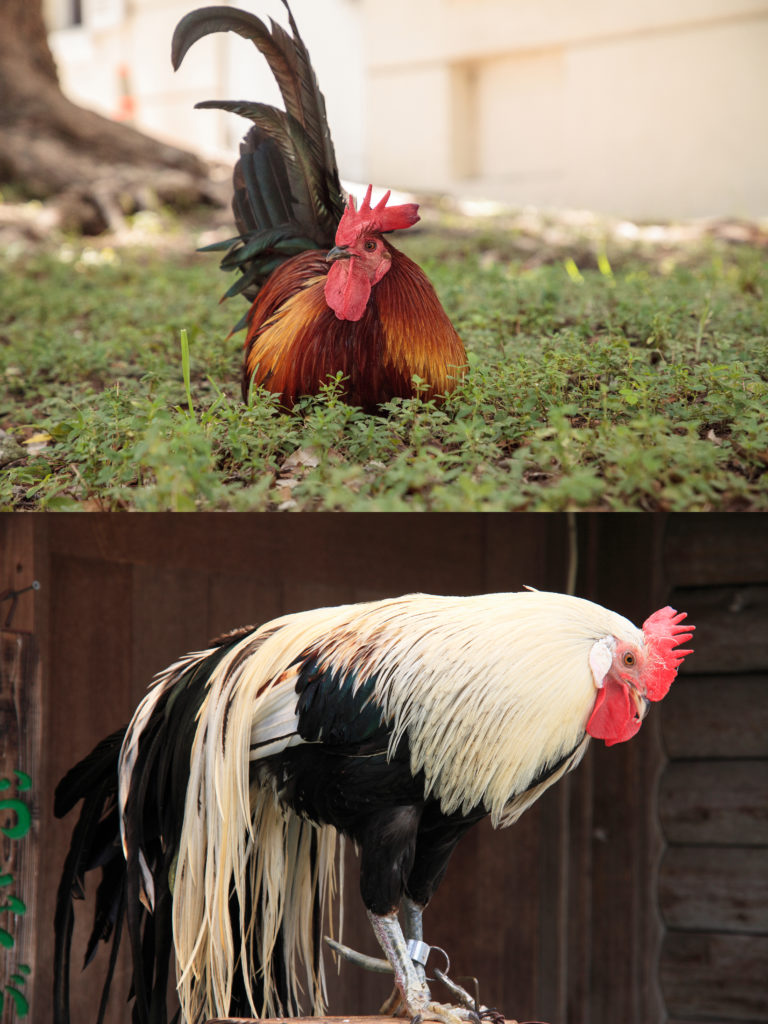
Two breeds of long-tailed chickens: the Cubalaya chicken, a Cuban breed and the Onagadori chicken, a Japanese breed.
There are also age categories so that older birds are not being compared to younger birds with less development. Pullets and cockerels are female and male birds under a year old, and they show in their own categories. Hens and cocks are over a year old and have their own sets of judging criteria.
Fairs are most often scheduled in late summer and early fall. Unfortunately, adult birds tend to molt in late summer and fall. Molting makes the birds look kind of sad and unkempt for judging. You’ll need to decide whether you want to show a molting bird or pick a different bird to show if your favorite one is shedding feathers.
Making Them Extra Pretty
It’s common for show animals to be cleaned up and prepped to look their best for the judges. Birds must be clean and look neat, so most chickens will need a shampoo. Wash and dry them carefully to avoid damaging feathers. Some hard-feathered birds, such as the Asil, Malay, or Ko-Shamo bantam, may only need their heads wiped off and feet scrubbed.
Bathe them at least three days before the show. Once they’re completely dry, your chickens will preen their feathers back into shape. Smooth-feathered breeds may need more time to replace the oil that’ll be washed away along with the dirt.
Work slowly and gently. Many birds get used to and even seem to enjoy the pampering. Birds that are accustomed to being handled appear to like having their feet and legs scrubbed. One chicken owner described her rooster as purring when she scrubbed his feet.
Baby oil or a little petroleum jelly can be applied gently to combs, wattles, legs, and feet for a finishing touch.
What to Expect with Judging
Who are the Judges?
Think about your judges for a moment. Judging is demanding work. At any APA-sanctioned show, the judges must be APA certified, which takes years of study. You can be sure that an APA judge knows a lot about chicken breeds. During the show, the row of cages is closed off while the judge is working, but after the show, most judges are willing to answer questions. They work part-time because they love the work, and they want to share their knowledge.
Practice with your Birds
Because the judges will exam every bird, holding them, checking their heads, legs, wings, and feathers, get your birds accustomed to being picked up and held before the competition. Get them used to having their combs, wattles, and feet touched, so they aren’t alarmed. Most birds adjust to handling. Some come to love it, while others simply tolerate it. Either way, your judges will appreciate a well-behaved bird.
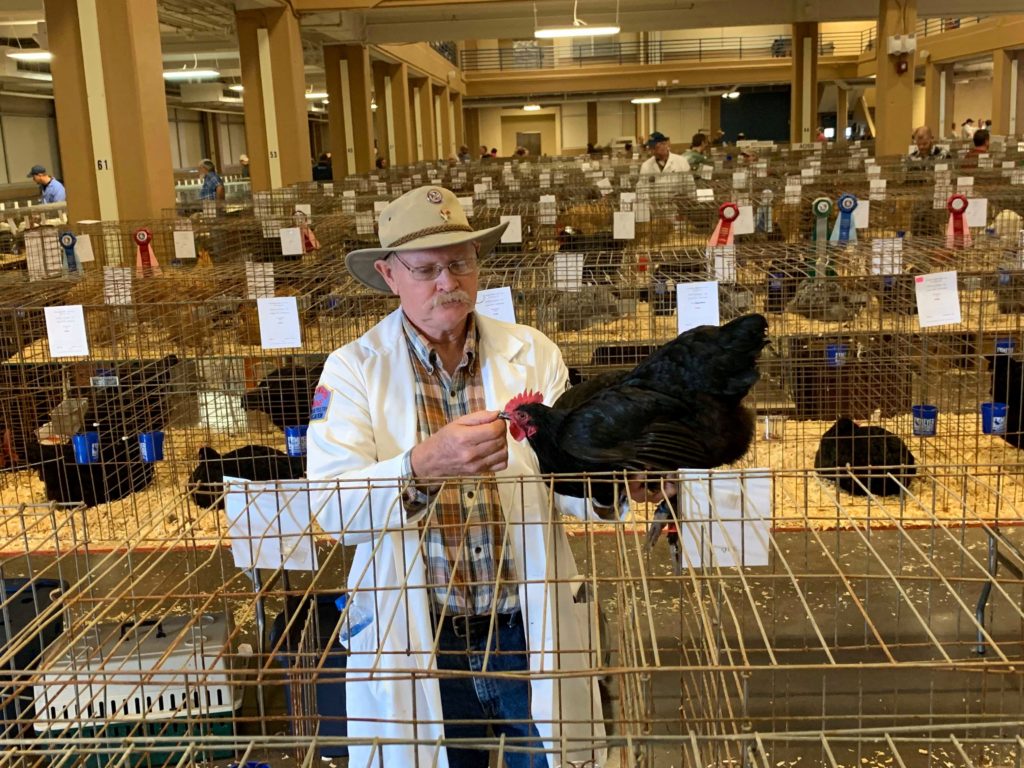
Ben Porter judging a Marans beak. Knoxville 2013 Poultry show. Photo by Elena del Aguila
You can also get your birds used to the whole process by practicing judging them. Put them in their show cage. Reward them with treats after you’ve worked with them. This will help keep them attentive and give them something to look forward to.
Judges use a telescoping metal stick to urge the birds to stand up, walk, and turn around so they can see the bird moving from different angles. It’s good practice to touch your show birds with a stick to get them used to being prodded by a judge.
Lots of Different Awards
After the first round of judging, the best examples of each breed and class are brought to Champions Row, usually in the center of the display floor. Ribbons, plaques, and prizes are awarded. Monetary prizes are modest, but you’ll enjoy recognition from your peers for your work in raising and prepping your birds.
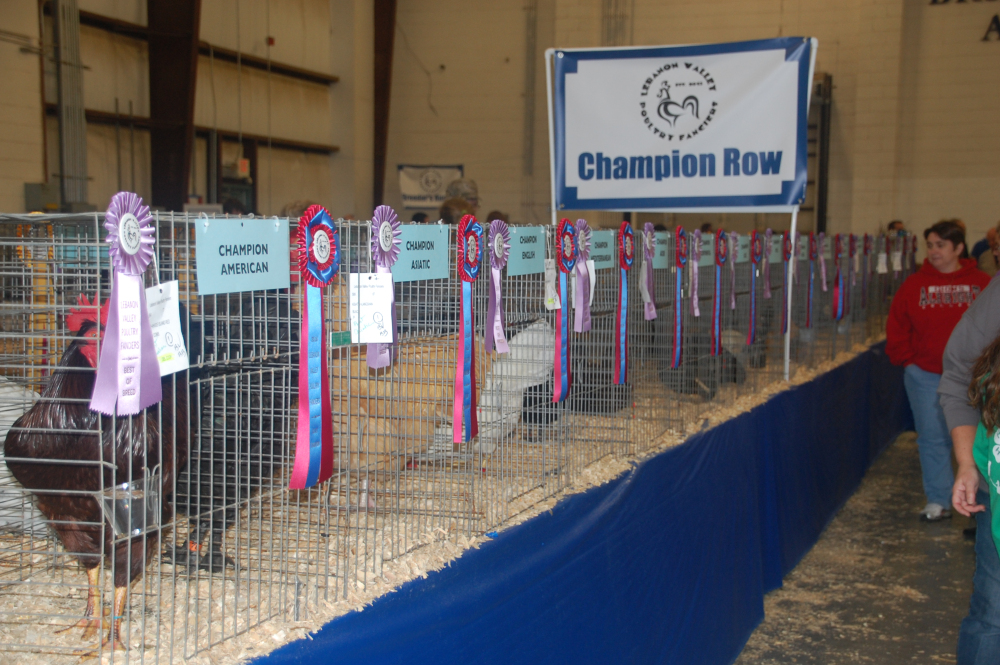
Champion Row. Photo by Paul Kroll.
Specialty breed clubs generally hold their own “meets” at poultry shows, and they award their own separate prizes. Be sure to attend the awards ceremony, even if you don’t win a prize or ribbon right away, because you can talk to those who do and make connections with folks who share your interests.
Biosecurity
Plan ahead for ways to keep your birds safe from disease, as they’re exposed to lots of other birds. The show organizers will have appropriate biosecurity measures in place to ensure that disease won’t be brought in or taken out. Read the show rules well ahead of time to understand and comply with the requirements. You may want to vaccinate your birds against some diseases. Your local poultry club or state extension agent, as well as the show secretary, can advise you on what’s required or advisable. There are also reliable websites where you can do your own research on diseases and vaccines to decide if you want to vaccinate or not.
Poultry diseases are serious. For example, most poultry shows in California were cancelled earlier this year (2019) because of an outbreak of Virulent Newcastle Disease in Southern California. Protect yourself and your birds.
Finding Your Way Around
Each bird has its own cage. Trios–one male and two females of the same breed, variety, and age–are shown and judged together.
The rows of cages are marked, but you need to know what the signs mean. “Open” means that the competition is open to all exhibitors, while “Juniors” means that all exhibitors are under the age of 18. Some shows separate them, and some have them compete together; it’s up to the local club sponsoring the show.
The cages are organized in groups: large fowl, bantams, waterfowl, turkeys, and guinea fowl.
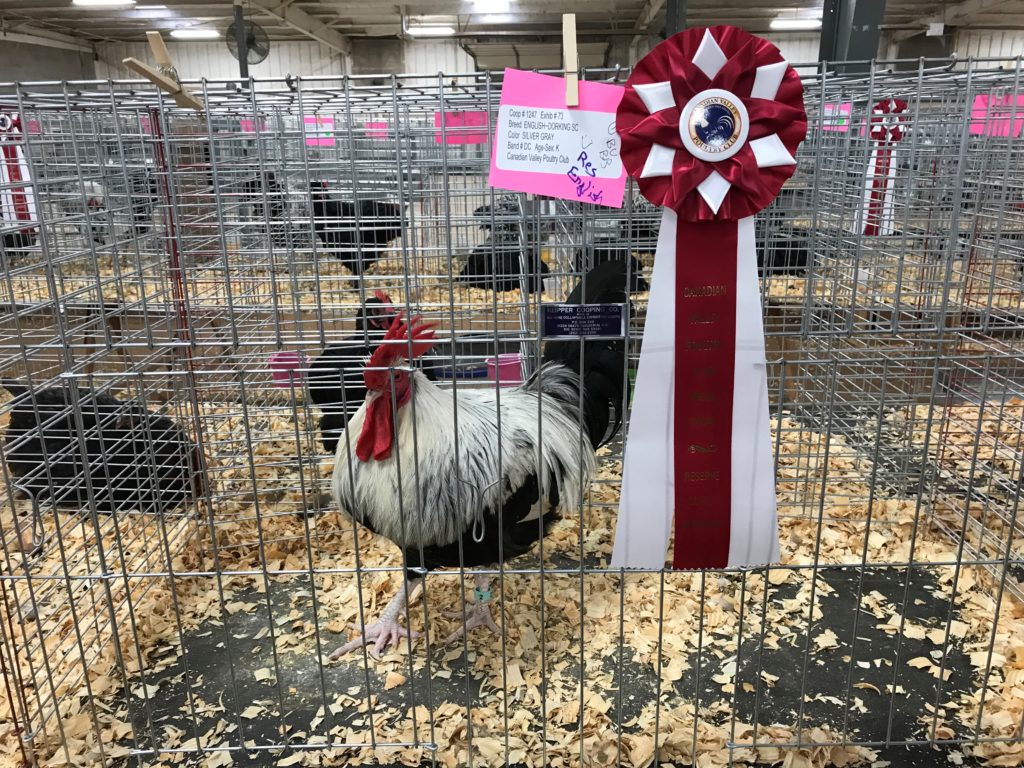
Dorking chicken. You can see the card and the ribbon awarded. Photo by John Monaco.
Each cage has a card attached to the front that provides basic information about the contained bird: breed, sex, and age. Each owner is assigned a number, which is also displayed on the cage. This number identifies which bird belongs to which breeder, and it also keeps the owners anonymous to the judges.

Buff Orpington. Photo by John Monaco.
The APA classifies chickens according to historic and geographical categories: American, English, Asiatic, Mediterranean, and Continental. Birds that don’t fit into one of those categories are listed as All Other Standard Breeds. Bantam chickens have their own classification system: Old English and American Game, Modern Game, Single Comb Clean Legged, Rose Comb Clean Legged, Feather Legged, and All Other Comb Clean Legged. They’re often identified by initials on the show signs, such as “RCCL” for Rose Comb Clean Legged.
Activities for the Whole Family
Lots of Information and Services
There’s a lot to do at shows besides show your birds. You’ll find tons of information and support from feed dealers and other vendors, as well as marketing outlets and services, such as photography. Whatever direction your flock is leading you, there will be someone at the show who can offer help and advice born of experience.
Shows often include silent auctions and raffles of poultry equipment and accessories, which is a great way to pick up bargains.
Younger Poultry Enthusiasts
Future Farmers of America (FFA) and 4-H clubs also host events at fairs for young people. For instance, a Quiz Bowl at a local show is a fun way for students to show what they know, and think on their feet. Student competitions, such as Elimination competitions, allow the winners to move on to national events that offer college scholarships and other substantial forms of recognition. In 2018, the FFA awarded $2.7 million in scholarships to 1,883 recipients in all 50 states and Puerto Rico.
Showmanship classes place students in a one-on-one examination with judges who interview young poultry owners on their knowledge and ability to handle their birds. It gives young enthusiasts an arena in which to show off their best birds and reveal what they really know about poultry.

Buying New Stock
Exhibitors can sell excess stock from the Sale aisle at most shows. This is a great way to acquire the surplus of a beautiful flock, either to start your own flock of that breed or as beautiful laying hens. Bring extra cages to take your new birds home.
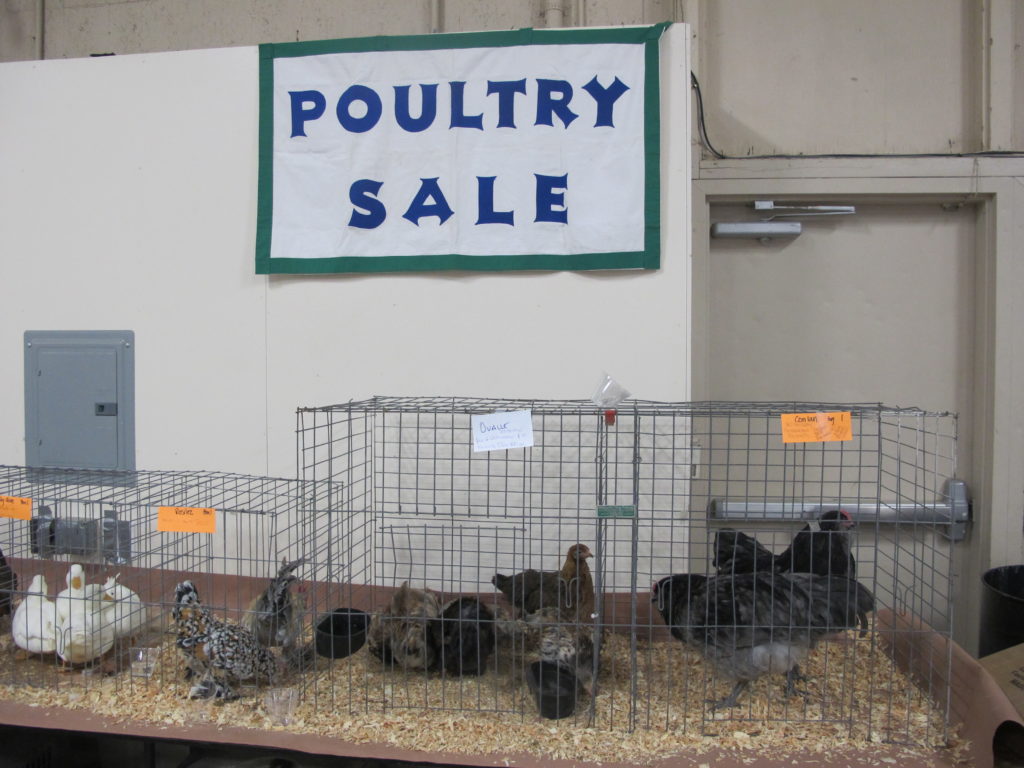
Pick up new stock for your flock at the poultry sale. Photo by John Monaco.
Making Contacts and Helping Out
Everyone is eager to pack up and head for home as the show winds down, but it’s rude to leave too early. Time to take a breath and foster those connections you made at the show.
- Offer to help with cleanup. Volunteers are the heart of every show. Be one of them.
- Settle accounts. Local clubs sponsor shows, and they never have enough money. Make sure you pay any bills you owe. Those trophies aren’t free.
- Confirm your address for future follow-up mailings. Then you’ll know what’s going on with planning the next show. The show secretary will be happy to accept your offer to volunteer.
Heading Home and Finishing Up
Observe biosecurity practices to keep the rest of your flock safe. Quarantine the birds that attended the show for at least 10 days. If they did pick up any disease, quarantining them will confine it to those few birds.
Share your experience by writing it up for the local paper. Post pictures on social media, along with hashtags and organization URLs. Chicken photos always attract Likes and Shares, which can help those organizations reach a larger audience. The organization is providing a venue for you to show your birds, so help them out via word of mouth and public recognition of their efforts.
Make a nice display of your ribbons and enjoy your successes. Learn from your mistakes. Give yourself and your birds a good rest before you do it again.
Christine Heinrichs writes from her home on California’s Central Coast. She keeps a backyard flock of a dozen hens, eight large fowl of various breeds and four bantams.
Her book, How to Raise Chickens, was first published in 2007, just as the local food movement was starting to focus attention on the industrial food system. Backyard chickens became the mascot of local food. The third edition of How to Raise Chickens was published in January 2019. The Backyard Field Guide to Chickens was published in 2016. Look for them in the Community Chickens online store and at Tractor Supply stores.
She has a B.S. in Journalism from the University of Oregon and belongs to several professional journalism and poultry organizations.













2 Comments
I love chickens
i am looking at showing my mottled pekin bantams in one of the NZ shows